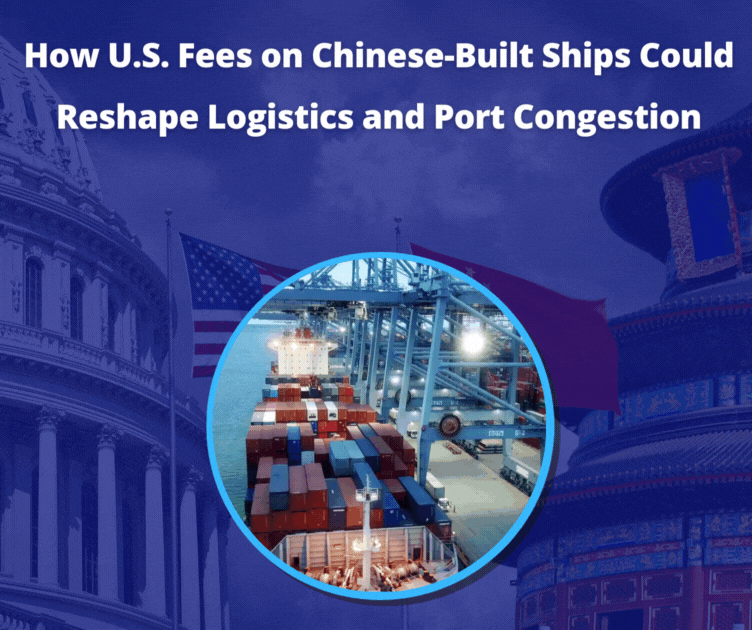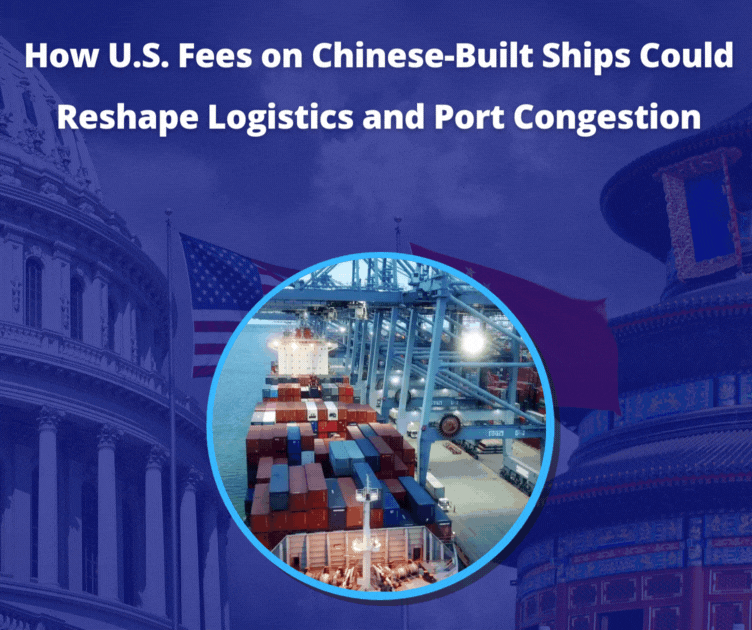
Potential Congestion, Costs, and Strategic Shifts in Shipping and Logistics
Intro
The logistics and shipping industry faces significant turbulence as the United States considers implementing substantial fees on vessels built in China. These proposed charges, aimed at reducing dependence on Chinese maritime manufacturing, could have profound ripple effects across the global shipping and logistics sectors. U.S. ports are already struggling with congestion and capacity issues, so the introduction of fees targeting Chinese-built ships raises concerns about exacerbating bottlenecks, increasing operational costs, and reshaping industry dynamics. Industry stakeholders must brace themselves for potential disruptions and strategize effectively to maintain efficiency, profitability, and competitiveness. This article explores the implications of these proposed fees by highlighting their potential impacts on logistics operations, costs, supply chain reliability, and industry innovation.
Understanding the Proposed Fees
The proposed U.S. regulations involve imposing substantial port entry fees on ships constructed in China. The primary goal of these measures is to decrease American dependency on Chinese maritime manufacturing, stimulate domestic shipbuilding sectors, and encourage diversification toward international shipyards outside China. Under the current proposal, vessels built in China could face significant surcharges, potentially ranging from $100,000 to $500,000 per vessel per year, depending on ship size, frequency of docking, and specific port policies.
Considering that Chinese shipyards dominate global shipbuilding markets (accounting for approximately 44% of the world’s shipbuilding output as of 2023), these fees represent a targeted economic countermeasure designed to disrupt China’s maritime industry influence. Notably, in 2022 alone, Chinese-built ships represented over 40% of container ships regularly docking at major U.S. ports such as Los Angeles, Long Beach, Savannah, and New York/New Jersey.
Logistics companies utilizing these ports would experience immediate and substantial cost escalations. The Port of Los Angeles— America’s busiest container port—handled approximately 9.9 million TEUs (Twenty-foot Equivalent Units) in 2023. A significant portion of these were transported via Chinese-built vessels. Additional fees on these ships could cumulatively cost shipping operators tens of millions of dollars annually, ultimately affecting freight pricing across industries.
Industry analysts warn that an unintended consequence of these proposed measures could be an accelerated shift toward alternative maritime routes and vessel procurement from shipyards in South Korea, Japan, and Europe—regions not subjected to similar fees. This shift could fundamentally alter global maritime trade patterns, resulting in the redistribution of traffic flows and potentially straining alternative ports not currently equipped to manage the influx of diverted vessels. Experts suggest that such disruptions might initially lead to congestion at alternative hubs. Thus, logistics providers must rapidly reassess supply chain strategies, port infrastructure capabilities, and contractual obligations.
Impacts on U.S. Port Congestion and Supply Chain Efficiency
The introduction of fees targeting Chinese-built ships poses the significant threat of worsening existing congestion issues at major U.S. ports. Ports such as Los Angeles and Long Beach, which handle roughly 40% of all U.S. container traffic and processed approximately 19.5 million TEUs collectively in 2023, are already strained, frequently operating near or at maximum capacity. An influx of diverted vessel traffic, as ship operators seek to avoid these additional charges, could exacerbate congestion, leading to prolonged waiting times and substantial operational inefficiencies.
According to a recent maritime industry analysis by Drewry, even minor disruptions at these critical hubs can lead to substantial delays, with each day of congestion costing shipping companies tens of thousands of dollars in demurrage and detention fees. Consequently, operators might seek alternative ports such as Vancouver, Ensenada, or Prince Rupert. However, these secondary ports are less equipped to handle substantial increases in container volumes, potentially overwhelming their infrastructure and logistical capabilities.
Shifts in shipping routes will extend lead times significantly, disrupting supply chain schedules and particularly affecting just-in-time inventory practices prevalent in sectors such as retail, automotive manufacturing, and electronics. Delays in product arrivals, even by a few days, can translate into lost sales and increased inventory holding costs. Thus, logistics companies might face pressure to rethink and revise warehouse capacities, inventory management techniques, and last-mile logistics. Industry experts, including those at Gartner Supply Chain Research, indicate that prolonged lead times and inconsistent delivery schedules could prompt increased investment in local warehousing, advanced tracking technologies, and inventory buffer stocks to mitigate disruption risks.
Cost Implications and Market Adjustments
The financial repercussions of the proposed fees are expected to permeate the supply chain, ultimately impacting consumers through increased prices. Industry projections suggest that shipping rates could rise by as much as 10% to 15%, which would translate into higher prices for consumer goods ranging from electronics and clothing to automotive parts and food items. A 2023 report by McKinsey estimated that even minor fee increments at key ports could collectively cost the U.S. logistics industry upwards of $2 billion annually, thereby significantly affecting overall profitability.
Logistics companies reliant on Chinese-built ships will likely seek to offset increased operational costs by raising service fees, renegotiating contracts with customers, or reducing costs elsewhere, potentially through workforce adjustments, lower service frequencies, or streamlined operational practices. Major shipping lines such as Maersk, MSC, and CMA CGM might be better positioned to absorb or redistribute these costs, but smaller operators, already dealing with narrow profit margins, are more vulnerable. Market consolidation could intensify, which, in turn, would disadvantage smaller and medium-sized firms unable to quickly pivot their strategies.
Furthermore, this regulatory shift might prompt logistics providers and shipping operators to reconsider fleet acquisition strategies and favor vessels constructed in shipyards located in South Korea, Japan, and Europe. These regions, which together represent about 40% of global shipbuilding output, according to Clarkson Research, could experience increased demand, thereby driving up newbuild prices and altering market competitiveness. The resulting shifts in procurement and production could realign global maritime supply chains significantly, reshaping industry dynamics, production timelines, and international trade patterns.
Strategic Shifts in Logistics and Supply Chains
To effectively navigate the challenges that the proposed fees pose, logistics firms will need to proactively reassess and strategically adapt their operational models. To mitigate potential negative impacts, companies can leverage several strategic responses:
- Diversifying Shipping Routes and Ports: Companies might strategically diversify their port usage, shifting container volumes toward less congested and less costly locations, such as ports on the U.S. East Coast, the Gulf Coast, or Canadian and Mexican alternatives. For instance, ports like Houston and Charleston, which experienced container volume growth exceeding 10% annually between 2021 and 2023, could attract increased traffic as viable alternatives.
- Forming Strategic Alliances and Partnerships: To maintain competitive pricing and manage heightened operational costs, logistics companies might increasingly collaborate through alliances and joint ventures. Pooling resources with other logistics operators or forming consortiums could reduce individual exposure to increased fees and enhance bargaining power with ports and suppliers.
- Fleet Diversification Investments: Shifts in fleet procurement toward vessels constructed outside of China—particularly in South Korean, Japanese, and European shipyards—will become increasingly prominent. According to BIMCO, a leading maritime industry association, new vessel orders in South Korean shipyards rose by 18% in 2023, reflecting early signs of diversification away from Chinese-built ships.
- Accelerating Technology Adoption: Investments in digital and technological solutions are expected to accelerate significantly. Technologies such as advanced predictive analytics, blockchain-based tracking systems, and AI-powered route optimization software will gain traction. A recent Deloitte survey indicated that, driven by the need to enhance operational resilience and efficiency amid mounting costs, 67% of logistics executives planned to significantly increase investments in digital logistics solutions by 2025.
Industry experts anticipate that these regulatory pressures will accelerate innovation and digitalization within the logistics industry, ultimately fostering greater efficiency, transparency, and agility in global supply chain operations.
Regulatory and Political Considerations
The geopolitical context surrounding the proposed fees significantly influences their potential implementation and impact. Heightened trade tensions between the United States and China, stemming from ongoing disputes over tariffs, intellectual property rights, and national security concerns, underline the complexity of these measures. Recent data from the U.S. Trade Representative indicates that over $600 billion in bilateral trade annually between the two nations remains under pressure. This suggests that logistics companies must remain vigilant and adaptive to rapidly evolving geopolitical dynamics.
Logistics firms need comprehensive strategies that include constant monitoring of international trade policies, diplomatic communications, and regulatory shifts. Industry-specific think tanks, trade organizations, and business associations such as the National Retail Federation (NRF), the American Association of Port Authorities (AAPA), and the World Shipping Council (WSC) are expected to actively engage policymakers through lobbying efforts. According to OpenSecrets, maritime and logistics industry lobbying expenditures in Washington increased by 12% in 2023—a fact that highlights intensified industry efforts to influence regulatory outcomes favorably.
Collaborative advocacy within the logistics sector could significantly shape the scope and final structure of the regulations. Effective coordination among industry stakeholders, led by data-driven arguments regarding economic impacts and supply chain disruptions, might influence policymakers to implement phased or mitigated versions of the proposed measures. Proactive engagement and joint initiatives could, therefore, play a pivotal role in moderating potentially disruptive aspects of these geopolitical-driven regulations.
Wrapping Up
The proposed fees on Chinese-built ships have significant implications for logistics companies, potentially reshaping shipping routes, supply chain strategies, cost structures, and consumer pricing. Logistics operators must remain agile and proactive and be ready to adapt their strategies swiftly in response to emerging challenges and opportunities. By preparing for increased costs, congestion, and strategic realignments, companies can navigate these stormy seas and maintain resilient, efficient, and competitive operations in the evolving global landscape.


